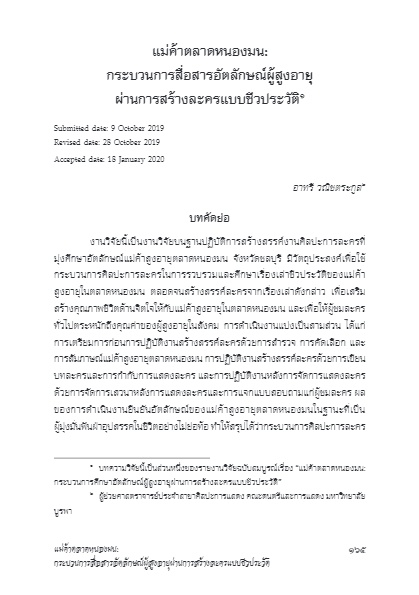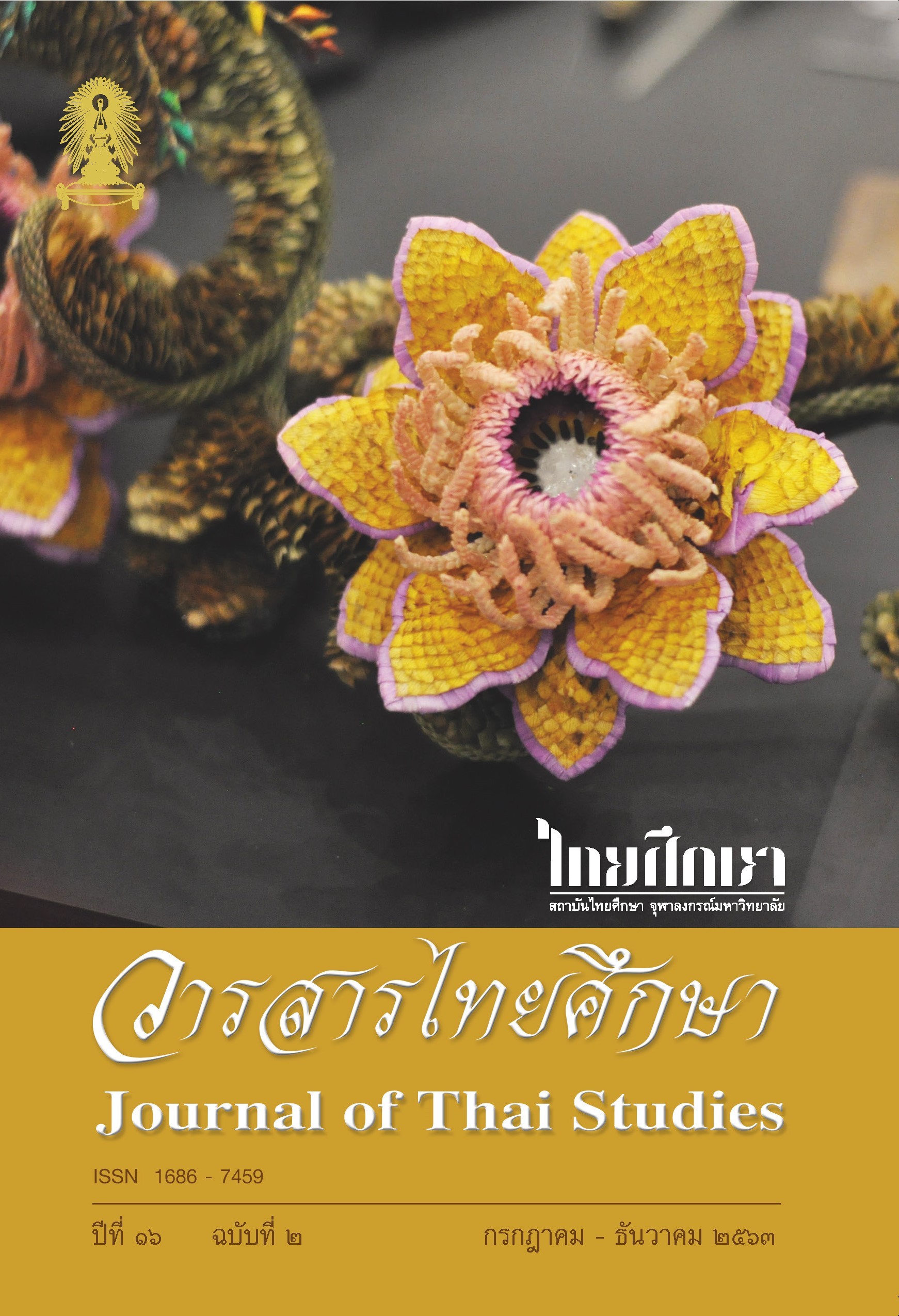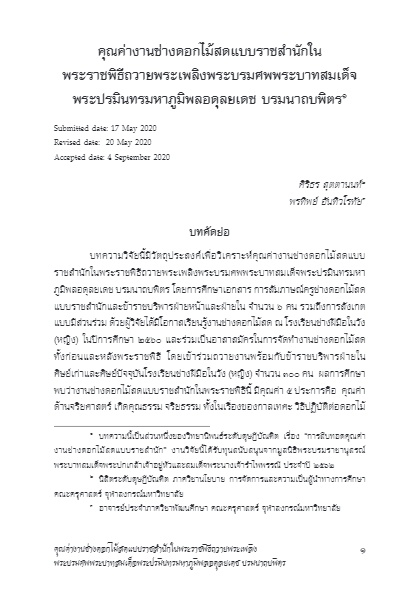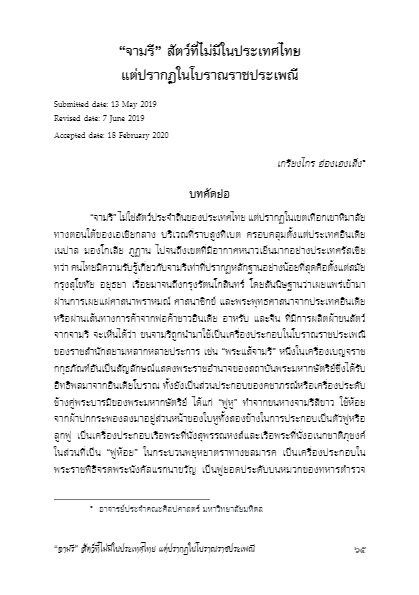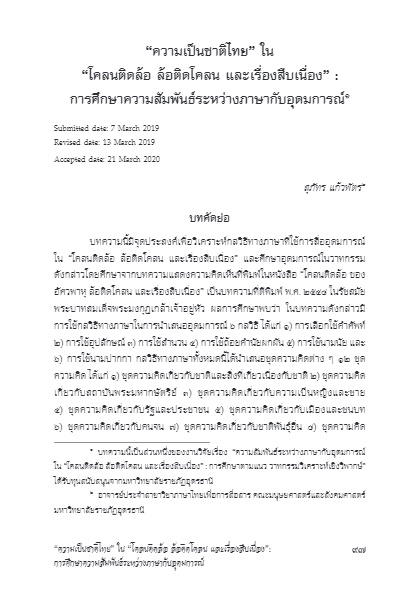วารสารไทยศึกษาปีที่ 16 ฉบับที่ 2

1)คุณค่างานช่างดอกไม้สดแบบราชสำนักในพระราชพิธีถวายพระเพลิงพระบรมศพพระบาทสมเด็จพระปรมินทรมหาภูมิพลอดุลยเดช บรมนาถบพิตร /ศิริธร สุตตานนท์ พรทิพย์ อันทิวโรทัย
2) ผ้าไหมไทยกับ “ความมั่นคงของมนุษย์” ในสมัยสงครามเย็น / ศิบดี นพประเสริฐ
3) “จามรี” สัตว์ที่ไม่มีในประเทศไทย แต่ปรากฏในโบราณราชประเพณี /เกรียงไกร ฮ่องเฮงเส็ง
4) “ความเป็นชาติไทย” ใน “โคลนติดล้อ ล้อติดโคลน และเรื่องสืบเนื่อง” : การศึกษาความสัมพันธ์ระหว่างภาษากับอุดมการณ์ / สุภัทร แก้วพัตร
5) ปถมมาลัย ทุติยมาลัย และจุฬลังคมาลัย กับประเพณีเทศน์มหาชาติของกลุ่มชาติพันธุ์ไท ที่วัดผาแตก อำเภอแม่สาย จังหวัดเชียงราย /จตุพร เพชรบูรณ์
6) แม่ค้าตลาดหนองมน: กระบวนการสื่อสารอัตลักษณ์ผู้สูงอายุผ่านการสร้างละครแบบชีวประวัติ /อาทรี วณิชตระกูล
คุณค่างานช่างดอกไม้สดแบบราชสำนักใน พระราชพิธีถวายพระเพลิงพระบรมศพพระบาทสมเด็จ พระปรมินทรมหาภูมิพลอดุลยเดช บรมนาถบพิตร
คุณค่างานช่างดอกไม้สดแบบราชสำนักในพระราชพิธีถวายพระเพลิงพระบรมศพพระบาทสมเด็จพระปรมินทรมหาภูมิพลอดุลยเดช บรมนาถบพิตร
ศิริธร สุตตานนท์
พรทิพย์ อันทิวโรทัย
บทคัดย่อ
บทความวิจัยนี้มีวัตถุประสงค์เพื่อวิเคราะห์คุณค่างานช่างดอกไม้สดแบบราชสำนักในพระราชพิธีถวายพระเพลิงพระบรมศพพระบาทสมเด็จพระปรมินทรมหาภูมิพลอดุลยเดช บรมนาถบพิตร โดยการศึกษาเอกสาร การสัมภาษณ์ครูช่างดอกไม้สดแบบราชสำนักและข้าราชบริพารฝ่ายหน้าและฝ่ายใน จำนวน 6 คน รวมถึงการสังเกตแบบมีส่วนร่วม ด้วยผู้วิจัยได้มีโอกาสเรียนรู้งานช่างดอกไม้สด ณ โรงเรียนช่างฝีมือวัง (หญิง) ในปีการศึกษา 2560 และร่วมเป็นอาสาสมัครในการจัดทำงานช่างดอกไม้สดทั้งก่อนและหลังพระราชพิธี โดยเข้าร่วมถวายงานพร้อมกับข้าราชบริพารฝ่ายใน ศิษย์เก่าและศิษย์ปัจจุบันโรงเรียนช่างฝีมือในวัง (หญิง) จำนวน 300 คน ผลการศึกษา พบว่างานช่างดอกไม้สดแบบราชสำนักในพระราชพิธีนี้ มีคุณค่า 5 ประการคือ คุณค่าด้านจริยศาสตร์ เกิดคุณธรรม จริยธรรม ทั้งในเรื่องของกาลเทศะ วิธีปฏิบัติต่อดอกไม้ ความกตัญญูต่อครูบาอาจารย์ และความรักชาติ ศาสนา พระมหากษัตริย์ คุณค่าด้านสุนทรียศาสตร์ เป็นการสัมผัสความงามในองค์ประกอบศิลป์ และการออกแบบที่เหมาะสมกับฐานานุภาพของภูมิปัญญาหลวง คุณค่าด้านการจัดการทรัพยากร เป็นการจัดการทรัพยากรในเชิงเศรษฐศาสตร์และการจัดการแบบโลจิสติกส์ ตั้งแต่การคัดสรร ควบคุมระยะเวลาในการจัดการวัตถุดิบ จนกระทั่งถึงการจัดการขนส่งชิ้นงานประดิษฐ์อย่างมีประสิทธิภาพ คุณค่าด้านเชิงช่างประณีตศิลป์ เป็น “งานช่าง” ในราชสำนัก โดย “ช่างประณีตศิลป์” คือ ผู้ประกอบไปด้วยองค์คุณสองประการ คือ มีฝีมือดีและความคิดดี รวมทั้งมีเทคนิคพิเศษ ได้แก่ วิธีการแบบรื้อสร้าง คือ การถอดรูปดอกไม้เดิมแล้วนำมาประกอบเป็นรูปแบบใหม่ และคุณค่าด้านนวัตกรรม เป็นการสร้างสรรค์นวัตกรรมใหม่โดยเชื่อมโยงองค์ความรู้งานช่างกับพิธีกรรม ศาสนา ก่อให้เกิดงานประดิษฐ์รูปแบบต่าง ๆ ที่ใช้วัสดุหลากหลายและมีความคงทนถาวร
คำสำคัญ : คุณค่า, งานช่างดอกไม้สด, แบบราชสำนัก, พระราชพิธีถวายพระเพลิงพระบรมศพ, พระบาทสมเด็จพระปรมินทรมหาภูมิพลอดุลยเดช บรมนาถบพิตร
(ตีพิมพ์ใน วารสารไทยศึกษา ปีที่ 16 ฉบับที่ 2 (กรกฎาคม-ธันวาคม 2563) หน้า 1-29)
The Values of Royal Pattern Floral Craftsmanship for The Royal Cremation of His Majesty King Bhumibol Adulyadej the Great
Siridhara Soottanon
Porntip Andhivarothai
Abstract
The aim of this research was to decode subtle meaning and significance of traditional floral arrangements at the Royal Cremation of the Thai King Rama IX. The research article focuses on a deep assessment of the flower arrangements dedicated to the late King Bhumibol Adulyadej the Great (H.M. King Rama IX). The study identified the hidden meaning and significance in the choice of floral patterns and arrangements as followings: 1. Ethical significance as represented in the steps taken by the artists to assemble fresh flowers daily that conveys a high level of moral characteristics, such as gratitude, respect and loyalty to teachers who bestowed their knowledge, to the nation, religion and the monarchy; 2. The aesthetics and beauty in the art form of flower arrangement in which can be traced back to the ancient wisdom of the Thai royal court passed on from generation to generation of artisans containing their beliefs, principles and religion; 3. Resource management from an intelligent selection of material through techniques adopted to arrange for the massive quantity of fresh flowers and transport them to be displayed at the right place at the right time in the most efficient manner possible; 4. The fine craftsmanship at the highest level of excellence and skillsets to generate beautiful artistic possibilities; and 5. Innovation beyond expectation but still realistic to be practical reflected in the imagination that comes from the mindset of the royal court artists and craftsmen.
Keywords: values; royal pattern; floral craftsmanship; royal cremation; King Bhumibol
(Published in Journal of Thai Studies Volume 16 Number 2 (July-December 2020) Page 1-29)
บทความ/ fulltext : 1_Siridhara.pdf
ผ้าไหมไทยกับ “ความมั่นคงของมนุษย์” ในสมัยสงครามเย็น
ผ้าไหมไทยกับ “ความมั่นคงของมนุษย์” ในสมัยสงครามเย็น
ศิบดี นพประเสริฐ
บทคัดย่อ
บทความนี้ศึกษาความเกี่ยวข้องระหว่างผ้าไหมไทยกับความมั่นคงของมนุษย์
ในสมัยสงครามเย็น และพบว่าผ้าไหมไทยมีบทบาทสำคัญในช่วงเวลาดังกล่าว แม้ว่า
ในช่วงแรกผ้าไหมไทยจะมีบทบาทในด้านการเสริมสร้างความมั่นคงของรัฐ (state
security) อันเป็นรูปแบบความมั่นคงแบบดั้งเดิม (traditional security) ผ่านการ
เผยแพร่ชื่อเสียงของประเทศด้วยการเป็นวัสดุในการประดิษฐ์ฉลองพระองค์ของ
สมเด็จพระนางเจ้าสิริกิติ์ พระบรมราชินีนาถ ในการโดยเสด็จพระบาทสมเด็จ
พระปรมินทรมหาภูมิพลอดุลยเดช เสด็จฯ เยือนสหรัฐอเมริกาและทวีปยุโรป อันส่งผลให้
ความสัมพันธ์ระหว่างไทยกับกลุ่มประเทศโลกเสรีมีความแน่นแฟ้นมากยิ่งขึ้น แต่ในเวลา
ต่อมา ผ้าไหมไทยมีบทบาทส่งเสริมความมั่นคงของมนุษย์ (human security) อันเป็น
รูปแบบหนึ่งของความมั่นคงรูปแบบใหม่ (non-traditional security) โดยมูลนิธิส่งเสริม
ศิลปาชีพในสมเด็จพระนางเจ้าสิริกิติ์ พระบรมราชินีนาถ สนับสนุนให้ประชาชนทอผ้า
เป็นอาชีพเสริม ส่งผลให้ประชาชนมีรายได้เพิ่มขึ้น มีชีวิตความเป็นอยู่ที่ดีขึ้นสามารถ
ปลดเปลื้องหนี้สิน เกษตรกรสามารถนำรายได้เสริมจากการทอผ้าไหมมาต่อยอดอาชีพ
เกษตรกรรมอันเป็นอาชีพหลักพร้อมทั้งยังมีทุนทรัพย์เพียงพอที่จะส่งบุตรหลานเข้าสู่ระบบการศึกษา อันเป็นการปูพื้นฐานชีวิตที่มั่นคงในอนาคต นับได้ว่ามีส่วนอย่างสำคัญในการส่งเสริมสภาวะความมั่นคงของมนุษย์ให้เกิดขึ้นในหมู่ประชาชนคนไทย แม้ว่าบริบททางการเมืองภายในและระหว่างประเทศในสมัยสงครามเย็นจะยังคงเน้นความมั่นคงแบบดั้งเดิมเป็นสำคัญอยู่ก็ตาม
คำสำคัญ : ผ้าไหมไทย, สงครามเย็น, ความมั่นคงของรัฐ, ความมั่นคงของมนุษย์
(ตีพิมพ์ใน วารสารไทยศึกษา ปีที่ 16 ฉบับที่ 2 (กรกฎาคม-ธันวาคม 2563) หน้า 31-63)
Thai Silk and “Human Security”
in the Cold War Period
Sibordee Nopprasert
Abstract
This article aims to study the relationship and important role between
Thai silk and human security. Initially, Thai silk had a role in spreading the
reputation of Thailand by being the material used to make dresses for Her
Majesty Queen Sirikit on the occasion of a state visit with His Majesty King
Bhumibol Adulyadej to the United States and Europe in 1960. Using Thai silk
for the Queen’s dresses was an important factor in making an impression on
host countries, which helped strengthen the relationship between Thailand
and Western countries in the Cold War period. However, in the 1970s, the
role of Thai silk shifted from supporting state security to supporting “human
security” by the SUPPORT Foundation, established by Queen Sirikit, to support
Thai farmers in weaving Thai silk, such as ikat silk. This became a part-time
job to earn extra income and brought about a better quality of life, although
“state security” and “traditional security” were still a major trend of security
studies in the Cold War period.
Keywords: Thai silk, Cold War, state security, human security
(Published in Journal of Thai Studies Volume 16 Number 2 (July – December 2020) Page 31-63)
บทความ/ fulltext :2_Sibodee.pdf
“จามรี” สัตว์ที่ไม่มีในประเทศไทย แต่ปรากฏในโบราณราชประเพณี
“จามรี” สัตว์ที่ไม่มีในประเทศไทย
แต่ปรากฏในโบราณราชประเพณี
เกรียงไกร ฮ่องเฮงเส็ง
บทคัดย่อ
“จามรี” ไม่ใช่สัตว์ประจำถิ่นของประเทศไทย แต่ปรากฏในเขตเทือกเขาหิมาลัยทางตอนใต้ของเอเชียกลาง บริเวณที่ราบสูงทิเบต ครอบคลุมตั้งแต่ประเทศอินเดีย เนปาล มองโกเลีย ภูฏาน ไปจนถึงเขตที่มีอากาศหนาวเย็นมากอย่างประเทศรัสเซีย ทว่าคนไทยมีความรับรู้เกี่ยวกับจามรีเท่าที่ปรากฏหลักฐานอย่างน้อยที่สุดคือตั้งแต่สมัยกรุงสุโขทัย อยุธยา เรื่อยมาจนถึงกรุงรัตนโกสินทร์ โดยสันนิษฐานว่าเผยแพร่เข้ามาผ่านการเผยแผ่ศาสนาพราหมณ์ ศาสนาซิกข์ และพระพุทธศาสนาจากประเทศอินเดีย หรือผ่านเส้นทางการค้าจากพ่อค้าชาวอินเดีย อาหรับ และจีน ที่มีการผลิตผ้าขนสัตว์จากจามรี จะเห็นได้ว่า ขนจามรีถูกนำมาใช้เป็นเครื่องประกอบในโบราณราชประเพณีของราชสำนักสยามหลากหลายประการ เช่น “พระแส้จามรี” หนึ่งในเครื่องเบญจราช กกุธภัณฑ์อันเป็นสัญลักษณ์แสดงพระราชอำนาจของสถาบันพระมหากษัตริย์ซึ่งได้รับอิทธิพลมาจากอินเดียโบราณ ทั้งยังเป็นส่วนประกอบของคชาภรณ์หรือเครื่องประดับช้างคู่พระบารมีของพระมหากษัตริย์ ได้แก่ “พู่หู” ทำจากขนหางจามรีสีขาวใช้ห้อยจากผ้าปกกระพองลงมาอยู่ส่วนหน้าของใบหูทั้งสองข้างในการประกอบเป็นตัวพู่หรือลูกพู่ เป็นเครื่องประกอบเรือพระที่นั่งสุพรรณหงส์และเรือพระที่นั่งอเนกชาติภุชงค์ ในส่วนที่เป็น “พู่ห้อย” ในกระบวนพยุหยาตราทางชลมารคเป็นเครื่องประกอบในพระราชพิธีจรดพระนังคัลแรกนาขวัญเป็นพู่ยอดประดับบนหมวกของทหารตำรวจ และราชองครักษ์ในพิธีสวนสนาม เป็นส่วนประกอบของเครื่องแขวนตามประตูและหน้าต่าง และเป็นเครื่องประดับอาวุธจำพวกหอกและทวนตามตำรายุทธพิชัยสงคราม เป็นต้น จึงเป็นที่มาของความสนใจศึกษาประวัติความเป็นมาของการนำขนจามรีมาใช้ในโบราณราชประเพณีของไทย
คำสำคัญ: จามรี, โบราณราชประเพณี, เบญจราชกกุธภัณฑ์, คชาภรณ์
(ตีพิมพ์ใน วารสารไทยศึกษา ปีที่ 16 ฉบับที่ 2 (กรกฎาคม-ธันวาคม 2563) หน้า 64 – 95)
Yak: The Animal Not Native to Thailand but
Native in Its Ancient Royal Tradition
Kriangkrai Honghengseng
Abstract
The yak is not an animal indigenous to Thailand, living in the areas of the Himalaya Range in the southern part of Middle Asia and the Tibetan Plateau, including India, Nepal, Mongolia, Bhutan to Russia. However, Thai people have had some knowledge about this animal at from the Sukhothai and Ayutthaya, until the early Rattanakosin period. This knowledge is assumed to have derived from the dissemination of Brahmanism, Sikhism and Buddhism by Indians, or from trade done by Indian, Arabian or Chinese merchants who produced yak wool. Yak wool has been used in Thai royal traditions for many occasions and in diverse manners. For example, it is the main part of “Yak Tail Fan”, a part of the royal regalia as a symbol of the monarch, showing the influence of Indian culture. Royal elephants are decorated with tassels made from white yak tail that hang down in front of their ears. The royal barges Suphannahong and Anekkachatphutchong in the grand royal barge procession have yak tail tassels in their bows. In addition, yak tail serves as a main component of the royal ploughing ceremony as a decoration on the hat worn by royal guards while marching in the color ceremony. As well, yak hair is used as ornaments for windows and gates and adorns spears and lances according to the treatise on war strategy. However, despite its extensive use, little research has been done on yak wool by Thai scholars. This paper aims to investigate the appearance of this exotic material in Thai royal tradition.
Keywords: yak, Thai royal traditional, royal regalia, ornaments of the royal Thai elephants
(Published in Journal of Thai Studies Volume 16 Number 2 (July – December 2020) Page 64 – 95)
บทความ/ fulltext :3_Kriangkrai.pdf
“ความเป็นชาติไทย” ใน “โคลนติดล้อ ล้อติดโคลน และเรื่องสืบเนื่อง” : การศึกษาความสัมพันธ์ระหว่างภาษากับอุดมการณ์
“ความเป็นชาติไทย” ใน
“โคลนติดล้อ ล้อติดโคลน และเรื่องสืบเนื่อง” :
การศึกษาความสัมพันธ์ระหว่างภาษากับอุดมการณ์
สุภัทร แก้วพัตร
บทคัดย่อ
บทความนี้มีจุดประสงค์เพื่อวิเคราะห์กลวิธีทางภาษาที่ใช้การสื่ออุดมการณ์ใน “โคลนติดล้อ ล้อติดโคลน และเรื่องสืบเนื่อง” และศึกษาอุดมการณ์ในวาทกรรมดังกล่าวโดยศึกษาจากบทความแสดงความคิดเห็นที่พิมพ์ในหนังสือ “โคลนติดล้อ ของอัศวพาหุ ล้อติดโคลน และเรื่องสืบเนื่อง” เป็นบทความที่ตีพิมพ์ พ.ศ. ๒๕๔๘ ในรัชสมัยพระบาทสมเด็จพระมงกุฎเกล้าเจ้าอยู่หัว ผลการศึกษาพบว่า ในบทความดังกล่าวมีการใช้กลวิธีทางภาษาในการนำเสนออุดมการณ์ ๖ กลวิธี ได้แก่ ๑) การเลือกใช้คำศัพท์ ๒) การใช้อุปลักษณ์ ๓) การใช้สำนวน ๔) การใช้ถ้อยคำนัยผกผัน ๕) การใช้นามนัย และ ๖) การใช้นามปากกา กลวิธีทางภาษาทั้งหมดนี้ได้นำเสนอชุดความคิดต่าง ๆ ๑๒ ชุดความคิด ได้แก่ ๑) ชุดความคิดเกี่ยวกับชาติและสิ่งที่เกี่ยวเนื่องกับชาติ ๒) ชุดความคิดเกี่ยวกับสถาบันพระมหากษัตริย์ ๓) ชุดความคิดเกี่ยวกับความเป็นหญิงและชาย ๔) ชุดความคิดเกี่ยวกับรัฐและประชาชน ๕) ชุดความคิดเกี่ยวกับเมืองและชนบท ๖) ชุดความคิดเกี่ยวกับคนจน ๗) ชุดความคิดเกี่ยวกับชาติพันธุ์อื่น ๘) ชุดความคิดเกี่ยวกับผู้ใหญ่และผู้น้อย ๙) ชุดความคิดเกี่ยวกับประชาธิปไตย ๑๐) ชุดความคิดเกี่ยวกับการเป็นพลเมืองที่ดี ๑๑) ชุดความคิดเกี่ยวกับพุทธศาสนา ๑๒) ชุดความคิดเกี่ยวกับความเป็น “พวกเขา” “พวกเรา” จากชุดความคิดทั้งหมดนี้สามารถสื่ออุดมการณ์ที่แฝงอยู่ในวาทกรรมดังกล่าวได้ ๓ อุดมการณ์ คือ ๑) อุดมการณ์ “ราชาธิปไตย”๑)อุดมการณ์ “ชาตินิยม” และ ๓) อุดมการณ์ “ปิตาธิปไตย” วาทกรรมนี้ได้นำเสนอแนวความคิดเกี่ยวกับ “ความเป็นชาติไทย” เพื่อต้องการให้คนไทยมีความจงรักภักดีต่อชาติ ศาสนาและพระมหากษัตริย์ ในขณะที่สภาพสังคมทั้งภายในและภายนอกประเทศกำลังเปลี่ยนแปลงไปสู่ยุคการปกครองแบบประชาธิปไตย
คำสำคัญ: ภาษา, อุดมการณ์, วาทกรรมวิเคราะห์เชิงวิพากษ์
(ตีพิมพ์ใน วารสารไทยศึกษา ปีที่ 16 ฉบับที่ 2 (กรกฎาคม-ธันวาคม 2563) หน้า 97 – 138)
“Thainess” in “CLOGS ON OUR WHEELS,
OUR CLOGGED UP WHEELS, AND THE OTHER
RELATED STORIES” : A study of the relationship
between language and ideology
Suphat Kaewphat
Abstract
This article aims to analyze the ideological linguistic strategies in “Clogs on Our Wheels, Our Clogged up Wheels, And the Other Related Stories”, and to analyze the discourses through critical articles in the book written by Asawabhahu “Clogs on Our Wheels, Our Clogged up Wheels, And The Other Related Stories”, published in 1915 during the reign of King Rama VI. Results of the study indicated that six linguistic strategies were used to present ideology: 1) lexical selection; 2) metaphor; 3) idioms; 4) verbal irony; 5) metonymy; and 6) pseudonym. These linguistic strategies presented 13 mindsets: 1) nationality mindset; 2) monarchy mindset; 3) gender mindset, male and female; 4) state and people mindset; 5) city and rural mindset; 6) poverty mindset; 7) ethnic groups mindset; 8) senior and junior mindset; 9) democracy mindset; 10) good population mindset; 11) Buddhism mindset; 12) ‘Theirs’ and ‘Us’ mindset; and 13) parents mindset. These mindsets show three latent ideologies in the discourse: 1) monarchy; 2) nationalism; and 3) paternalism. These discourses demonstrate ideas about Thainess to make Thai people loyal to the concept of Nation, Religion and Monarch because the situation of Thailand, both inside and outside the country, was transforming into a new regime, democracy.
Keywords : Language, Ideology, Critical Discourse Analysis ( CDA)
(Published in Journal of Thai Studies Volume 16 Number 2 (July – December 2020) Page 97-138)
บทความ/ fulltext :4_Supat.pdf
ปถมมาลัย ทุติยมาลัย และจุฬลังคมาลัย กับประเพณีเทศน์มหาชาติของกลุ่มชาติพันธุ์ไท ที่วัดผาแตก อำเภอแม่สาย จังหวัดเชียงราย
ปถมมาลัย ทุติยมาลัย และจุฬลังคมาลัย กับประเพณีเทศน์มหาชาติของกลุ่มชาติพันธุ์ไท ที่วัดผาแตก อำเภอแม่สาย จังหวัดเชียงราย
จตุพร เพชรบูรณ์
บทคัดย่อ
บทความนี้มีวัตถุประสงค์เพื่อศึกษาคัมภีร์พระมาลัยของกลุ่มชาติพันธุ์ไทคือชาวไทใหญ่ ไทเขิน และไทลื้อ ที่บ้านผาแตก ตำบลเวียงพางคำ อำเภอแม่สาย จังหวัดเชียงราย เปรียบเทียบกับคัมภีร์พระมาลัยสำนวนไทยวนและสำนวนไทยอีสาน และเพื่อศึกษาความสัมพันธ์ระหว่างคัมภีร์พระมาลัยกับประเพณีเทศน์มหาชาติของกลุ่มชาติพันธุ์ไทที่บ้านผาแตก ผลการศึกษาพบว่า พระมาลัยสำนวนของกลุ่มชาติพันธุ์ไทมี ๓ พับ เรียกว่า ปถมมาลัย ทุติยมาลัย และจุฬลังคมาลัย ในขณะที่ของไทยวนมี ๒ ผูก เรียกว่า ปฐมมาลัย และ ทุติยมาลัย ส่วนของไทยอีสานมี ๒ ผูกเรียกว่า มาลัยหมื่น-มาลัยแสน ด้านเนื้อหาพบว่า คัมภีร์ปถมมาลัย ทุติยมาลัย ของกลุ่มชาติพันธุ์ไทที่บ้านผาแตก มีใจความตรงกับคัมภีร์ปฐมมาลัยและทุติยมาลัยของไทยวน และตรงกับคัมภีร์มาลัยหมื่น-มาลัยแสนของไทยอีสาน ผูกแรกกล่าวถึงพระมาลัยนำดอกบัว ๘ ดอก ที่ได้รับจากชายยากจนไปสักการะพระธาตุจุฬามณีที่สวรรค์ชั้นดาวดึงส์ ผูกที่สองพระมาลัยพบกับพระศรีอาริย์ ซึ่งสั่งความให้พระมาลัยบอกมนุษย์ว่าหากปรารถนา
(ตีพิมพ์ใน วารสารไทยศึกษา ปีที่ 16 ฉบับที่ 2 (กรกฎาคม-ธันวาคม 2563) หน้า 139-164)
Pathom Malai, Thutiya Malai and Chunlangkha
Malai and the Thet Maha Chat Tradition of
Tai Ethnic Groups at Wat Pha Take
Mai Sai District Chiang Rai Province
Chatuporn Petchaboon
Abstract
The objectives of this article are to investigate three versions of Phra Malai scripture: Tai Yuan, Thai Isan and an ethnic group of Tai Yai, Tai Khoen and Tai Lue at Wat Pha Taek, Tambon Wiang Phang Kham, Mae Sai District, Chiang Rai Province. The investigation was on the content and the relationship between Phra Malai scriptures and the tradition of Maha Chat sermons. The study found that Phra Malai scriptures versions of Tai Yuan and Thai Isan have two parts. The two parts of the Tai Yuan version are called Pathom Malai and Thutiya Malai, while the two parts of the Thai Isan version are called Malai Muen and Malai Saen. However, the Phra Malai scripture version of the ethnic Tai group kept at Wat Pha Taek, Tambon Wiang Phang Kham, Mae Sai District, Chiang Rai Province has three parts called Pathom Malai, Thutiya Malai and Chunlangkha Malai. Regarding the content, the first two parts of all three versions of Phra Malai scriptures are the same, with the first part about Phra Malai taking eight lotus flowers offered to him by a poor man to pay homage to Phra That Chula Mani in Daowadueng Heaven. The second part is about Phra Malai meetingPhra Sri-arya who instructs Phra Malai to inform humans that if they desire to be born in his religion, they should prepare a thousand items of offerings to Dhamma and listen to all the sermons of Maha Chat in one day. For the third part of Phra Malai scripture, the content continues about Phra Malai coming down to Chomphu Thawip or Jambudvipa to inform humans of Phra Sri-araya’s instructions, but with the humans negotiating that the poor could not afford a thousand items of offerings. Thus, when Phra Malai and Chunlangkha Ubasok went to ask Phra Sri-araya for permission to offer less items, permission was granted, and if the Thet Maha Chat could not be organized by one person, it could be jointly organized by many people. The study found further: 1) the tradition of Thet Maha Chat among Tai Yuan, Thai Isan and the Tai ethnic group at Ban Pha Taek listen to Phra Malai sermons before Maha Chat sermons; 2) Phra Malai scriptures describe the origin of the Thet Maha Chat tradition, the length of time for the sermons
and the arrangement of the thousand offering items for Thet Maha Chat; and 3) Chunlangkha Malai describes the origin of Thet Maha Chat of the Tai ethnic group at Wat Pha Taek where Thet Maha Chat is classified into two types according to how the sermons are organized: Tang Dhamma Wessantara jointly hosted by people in the community and Than Maha Pang hosted by an individual person or a couple who are husband and wife.
Keywords: Phra Malai, Pathom Malai, Thutiya Malai, Chullangkha Malai,
Thet Maha Chat
(Published in Journal of Thai Studies Volume 16 Number 2 (July – December 2020) Page139-164)
บทความ/ fulltext :5_Chatuporn.pdf
แม่ค้าตลาดหนองมน: กระบวนการสื่อสารอัตลักษณ์ผู้สูงอายุ ผ่านการสร้างละครแบบชีวประวัติ
แม่ค้าตลาดหนองมน: กระบวนการสื่อสารอัตลักษณ์ผู้สูงอายุ ผ่านการสร้างละครแบบชีวประวัติ
อาทรี วณิชตระกูล
บทคัดย่อ
งานวิจัยนี้เป็นงานวิจัยบนฐานปฏิบัติการสร้างสรรค์งานศิลปะการละครที่มุ่งศึกษาอัตลักษณ์แม่ค้าสูงอายุตลาดหนองมน จังหวัดชลบุรี มีวัตถุประสงค์เพื่อใช้กระบวนการศิลปะการละครในการรวบรวมและศึกษาเรื่องเล่าชีวประวัติของแม่ค้าสูงอายุในตลาดหนองมน ตลอดจนสร้างสรรค์ละครจากเรื่องเล่าดังกล่าว เพื่อเสริมสร้างคุณภาพชีวิตด้านจิตใจให้กับแม่ค้าสูงอายุในตลาดหนองมน และเพื่อให้ผู้ชมละครทั่วไปตระหนักถึงคุณค่าของผู้สูงอายุในสังคม การดำเนินงานแบ่งเป็นสามส่วน ได้แก่ การเตรียมการก่อนการปฏิบัติงานสร้างสรรค์ละครด้วยการสำรวจ การคัดเลือก และการสัมภาษณ์แม่ค้าสูงอายุตลาดหนองมน การปฏิบัติงานสร้างสรรค์ละครด้วยการเขียนบทละคร และการกำกับการแสดงละคร และการปฏิบัติงานหลังการจัดการแสดงละครด้วยการจัดการเสวนาหลังการแสดงละคร และการแจกแบบสอบถามแก่ผู้ชมละคร ผลของการดำเนินงานยืนยันอัตลักษณ์ของแม่ค้าสูงอายุตลาดหนองมนในฐานะที่เป็นผู้มุ่งมั่นฟันฝ่าอุปสรรคในชีวิตอย่างไม่ย่อท้อ ทำให้สรุปได้ว่ากระบวนการศิลปะการละครสามารถช่วยเสริมสร้างคุณภาพชีวิตด้านจิตใจให้กับผู้สูงอายุได้ อีกทั้งยังสามารถทำให้ผู้ชมละครทั่วไปตระหนักถึงคุณค่าของผู้สูงอายุในสังคมได้อีกด้วย
คำสำคัญ : ผู้สูงอายุ, อัตลักษณ์, ละครแบบชีวประวัติ, ตลาดหนองมน, จังหวัดชลบุรี
(ตีพิมพ์ใน วารสารไทยศึกษา ปีที่ 16 ฉบับที่ 2 (กรกฎาคม-ธันวาคม 2563) หน้า 165 – 186)
Nong Mon Market Female Vendors: Identity Communication Process of the Elderly through Biographical Play
Arthri Vanichtrakul
Abstract
The aim of this creative theatrical process, as practice based research, is to study the identities of elderly female vendors at Nong Mon market in Chonburi province. The objective of the research is to create a play based on the biographies of the elderly female vendors at Nong Mon market by
using the theatrical process to compile their selected stories. This will not only strengthen the spirit of the elderly female vendors at Nong Mon market, but also encourage the audience to consider the value of the elderly in society. The working processes consisted of three stages: the pre-production process – surveying, classification and interviewing the elderly female vendors at Nong Mon Market; the production process – script writing and play directing; and the post-production process – post play talk and questionnaires given to the audience. The findings reveal that the elderly female vendors at Nong Mon market are ones who have inexorably overcome obstacles of life. In conclusion, the theatrical process can shape and strengthen the spirit of the elderly, and make the audience appreciate the value of the elderly in society as well.
Keywords: the elderly, identity, biographical play, Nong Mon market, Chonburi province
(Published in Journal of Thai Studies Volume 16 Number 2 (July – December 2020) Page 165 -186)
บทควบทความ/ fulltext :6_Arthri.pdf